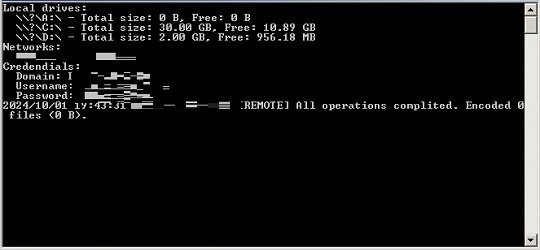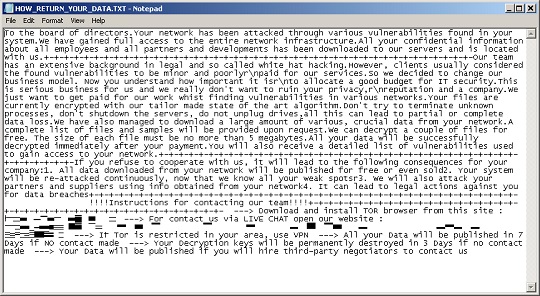Ransom.Win64.LDRADO.THCBOBD
Windows


Threat Type: Ransomware
Destructiveness: No
Encrypted:
In the wild: Yes
OVERVIEW
This Ransomware arrives on a system as a file dropped by other malware or as a file downloaded unknowingly by users when visiting malicious sites.
It drops files as ransom note. It avoids encrypting files with the following file extensions.
TECHNICAL DETAILS
Arrival Details
This Ransomware arrives on a system as a file dropped by other malware or as a file downloaded unknowingly by users when visiting malicious sites.
Installation
This Ransomware adds the following processes:
- vssadmin Delete Shadows /all /quiet
- cmd "/c chcp 65001 & systeminfo"
Information Theft
This Ransomware accepts the following parameters:
- -skip-local → Skip processing local files.
- -skip-net → Skip processing shares
- -keep → Disable self-deletion after execution (Self-deletion is enabled by default).
- -n
→ Specify network in CIDR format. If not specified, values from active network interfaces will be used. A file with a list of networks can also be specified. - -d
→ Specifies a domain. - -u
→ Specifies username for SMB. - -p
→ Specifies password for SMB.
Other Details
This Ransomware does the following:
- It gathers the following data via systeminfo:
- Operating System Information:
- Name
- Version
- Manufacturer
- Configuration
- Build Type
- Registered Owner
- Registered Organization
- Product ID
- Installation date
- Host name
- System Boot Time
- System Manufacturer
- System Architecture
- Processor information
- System Language
- Time Zone Information
- BIOS Version
- Total and Available Physical Memory
- Virtual Memory Information (Max, Available, In Use)
- Page file locations
- Domain
- Logon server
- Hotfix(es)
- Network card(s)
- It displays its logs on a console:

- It sends some of its logs to the following IP Address:
- {BLOCKED}.{BLOCKED}.{BLOCKED}.152:443
Ransomware Routine
This Ransomware avoids encrypting files with the following strings in their file name:
- ntldr
- ntdetect.com
- autoexec.bat
- ntuser.dat
- ntuser.dat.log
- iconcache.db
- bootsect.bak
- bootfont.bin
- bootmgr
- thumbs.db
It avoids encrypting files found in the following folders:
- Windows
- programdata
- program files
- program files (x86)
- $recycle.bin
- all users
- winnt
- appdata
- application data
- local settings
- boot
It appends the following extension to the file name of the encrypted files:
- .00000001
It drops the following file(s) as ransom note:
- {Encrypted Directory}\HOW_RETURN_YOUR_DATA.txt

It avoids encrypting files with the following file extensions:
- .00000001
- .exe
- .dll
- .sys
- .msi
- .ini
- .inf
- .lnk
SOLUTION
Step 1
Trend Micro Predictive Machine Learning detects and blocks malware at the first sign of its existence, before it executes on your system. When enabled, your Trend Micro product detects this malware under the following machine learning name:
- Troj.Win32.TRX.XXPE50FFF081
Step 2
Before doing any scans, Windows 7, Windows 8, Windows 8.1, and Windows 10 users must disable System Restore to allow full scanning of their computers.
Step 3
Note that not all files, folders, and registry keys and entries are installed on your computer during this malware's/spyware's/grayware's execution. This may be due to incomplete installation or other operating system conditions. If you do not find the same files/folders/registry information, please proceed to the next step.
Step 4
Search and delete these files
- {Encrypted Directory}\HOW_RETURN_YOUR_DATA.TXT
Step 5
Scan your computer with your Trend Micro product to delete files detected as Ransom.Win64.LDRADO.THCBOBD. If the detected files have already been cleaned, deleted, or quarantined by your Trend Micro product, no further step is required. You may opt to simply delete the quarantined files. Please check the following Trend Micro Support pages for more information:
Step 6
Restore encrypted files from backup.
Did this description help? Tell us how we did.


